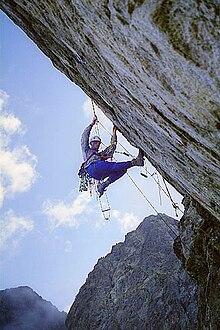Technical climbing

Aid climbing referred to in mountaineering , the climbing on rock with tools such as hooks , ropes and rope ladders that are used for locomotion. In contrast to this, aids for free climbing are only used to protect against falling.
In the simplest form, the safety devices are used as a grip or step in technical climbing, for example on via ferrata . As the difficulty increases, rock hooks are struck on which the climber hangs or on which he can ascend the rope. For nature conservation reasons and due to the technical development of securing materials, mobile clamping devices are often used today .
In addition, rope ladders are also used for standing and climbing. It can even be used to overcome a horizontal roof by hooking a series of hooks into a crack, always with the hook heads pointing down, from which you slowly work your way up. Completely smooth wall sections without any cracks to drive a hook in can be climbed by drilling holes and dowelling, cementing or gluing bolts in. All of these techniques are very tedious and require extensive equipment. Long routes from around 800 or 1000 meters wall height can usually no longer be climbed in a day, so that you have to bivouack in the wall .
In technical climbing there is a rating scale that rates the difficulty of technical climbing from A0 to A5 (a: “artificial”), depending on the effort, the difficulty of hooking and the strength of the rock.
Technical climbing was developed by climbers in the Alps in the 1920s . Until then not yet ascended walls could (with the former technique and equipment hemp ropes, spiked shoes ) are not defeated in free climbing. Therefore, one began to use additional resources.
In the 1930s, with the help of technical climbing, all famous north faces of the Alps were ascended, e.g. B. on the Matterhorn , Grandes Jorasses , Piz Badile , Dru , Großer Zinne and Eiger north face .
After the Second World War, technical climbing was further developed and increasingly repulsive routes were climbed with the help of bolts. Since practically everything can be climbed in this way, the development of technical climbing came to a dead end. In the 1970s, free climbing became more popular again as a counter-movement. Since then the possibilities of free climbing have been expanded more and more through better techniques, training and equipment. Nowadays, free climbing is preferred whenever possible. Technical climbing is still used in big wall climbing and in the long, extreme routes of the Alps.
Technical climbing has also been used in commercial areas. Together with the rigging of the sail , rope techniques have developed which today form independent professions. These include the single rope technique used by cave researchers , rope climbing technique (SKT) in tree care, rope access technique (SZT) in the industrial sector, height rescue , rigging in event technology , stunt rigging and aerial rigging .
See also
literature
- Author collective: mountaineering. Sportverlag, Berlin (East) 1975.
- Pepi Stückl, Georg Sojer: Mountaineering. Textbook and guide for all types of mountaineering. Bruckmann, Munich 2002, ISBN 3-7654-3683-6 .